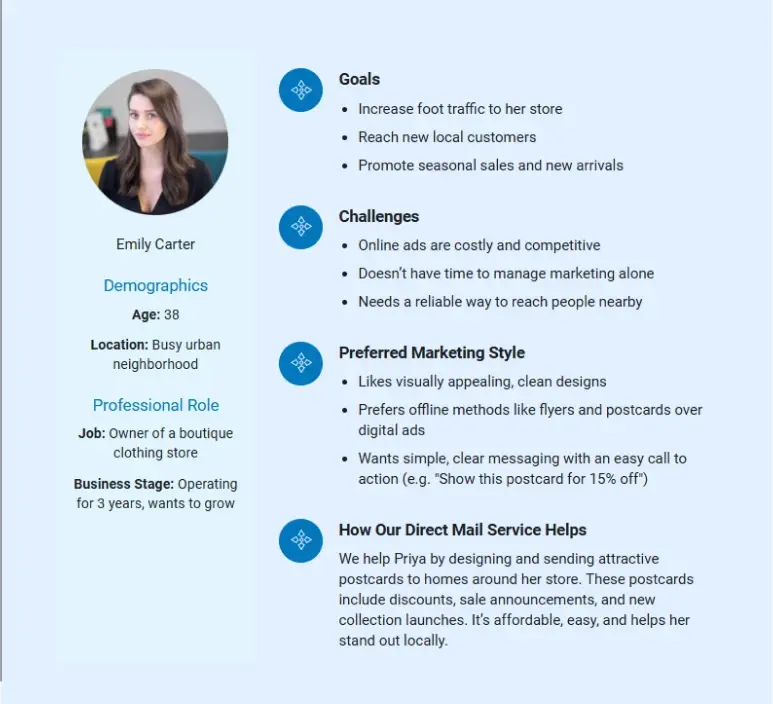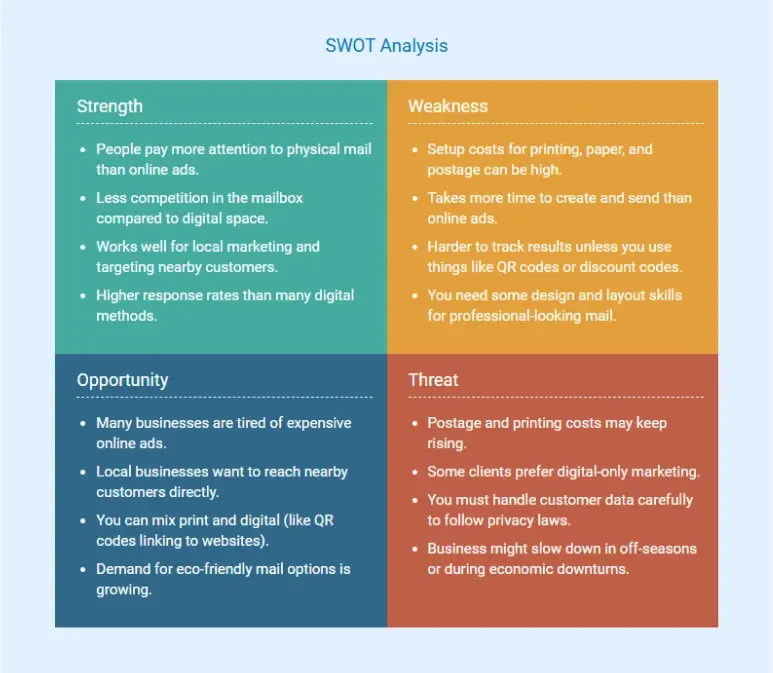Thinking of starting a direct mail business? Smart move—direct mail has open rates up to 90%, far higher than email.
But before you launch your direct mail venture, you need a solid plan to guide you. It helps you to outline services, attract clients, manage daily operations, and stay profitable.
In this guide, we’ll walk you through each section of a direct mail business plan, from the executive summary to the financials, with tips, examples, and even give you a free direct mail business plan template to get started.
Let’s dive in!
What is a direct mail business plan?
A direct mail business plan is a blueprint that outlines your company’s objectives and how you’ll achieve them. It covers everything from services you offer (like designing, printing, and mailing) to your target market, competition, operations, marketing strategy, and financial projections.
Tailored for the direct mail industry, it also touches on market demand and logistics. Whether you’re using it to guide your growth or share with investors, it helps turn your idea into a clear, structured, and profitable business.
Why do you need a direct mail business plan?
You might be excited to start working with clients and sending mail, but it’s important to take time to create a business plan. Here’s why:
- Gives you direction: A plan helps you understand your business, choose your target customers, and set clear goals. It saves you from guessing and making random decisions.
- Helps you get funding: If you need money to start, like for printers or supplies, banks and investors will want to see how you’ll earn and manage money.
- Increases your chances of success: Planning ahead helps you see possible problems early and think of ways to solve them.
- Keeps you focused: A plan sets clear goals and steps to follow, so you stay on track as your business grows.
In summary, writing a business plan will save you time, money, and headaches in the long run.
How to create a direct mail business plan?
Creating a business plan may sound like a big task, but it’s much easier when you break it down into sections. A direct mail business plan includes several key components, each focusing on an aspect of your business.
1. Executive Summary
The executive summary is the first section of your business plan, but it’s usually easiest to write it last, after you’ve detailed everything else. That way, you can accurately summarize important details from later sections.
It’s a high-level overview of your entire plan, typically one or two pages that give the reader a quick snapshot of your direct mail business and why it will succeed.
Here’s what to include in your executive summary:
- Basics of your company
- Your mission and vision statement
- Unique selling proposition
- Your target market
- Your financial goals
- Funding needs (if any)
Keep the tone clear and information concise. Also, try to make it engaging—this section might determine whether a reader (or investor) is interested enough to read on.
Say goodbye to boring templates
Build your business plan faster and easier with AI
Plans starting from $14/month

2. Business Overview
The business overview section provides more background on your direct mail company. In this section, you’ll have to expand on the basics and give context about your business. Like:
- Business name and location: Write your company name and where you’ll work. Will you have a shop or work from home?
- Business type: Say if you’re a sole owner, have a partner, or are a registered company.
- Start date and stage: Mention when you started (or plan to start) and whether you’re just starting out or already running.
Other details you need to include are:
Mission and Vision
Write a short mission statement—what your business wants to achieve. For example: “To help businesses grow by sending effective direct mail.”
Also, share your vision, like becoming the top direct mail company in your area.
What You Offer
Briefly list your main services, like printing mailers, managing mailing lists, or running full campaigns.
Why is Your Business Needed
Explain the problem you’re solving—for example, helping local businesses keep customers with loyalty mailers.
Your Goals
Mention your short-term and long-term goals, like getting your first 10 clients or growing into new areas in 5 years.
Keep this section factual and straightforward. It should give a quick and clear idea of who you are and what your business does.
3. Market Analysis
In this section, you’ll demonstrate your understanding of the direct mail industry and market. A thorough market analysis is crucial—it proves that there is demand for your services and that you know the environment you’re entering.
Start by discussing the direct mail industry at large. For example:
“Despite the rise of digital marketing, direct mail remains a multi-billion dollar industry, with U.S. direct mail advertising spending projected to reach about $13.2 billion (out of a nearly $77 billion global market).” This shows that many businesses are still investing in mail marketing.
Next, define who your ideal customers are. Are they small or medium business owners? Or particular industries? Describe what your customers need and who they are.
To really illustrate your target market, you might include a customer persona of an ideal client. For example:

Also, mention any important market trends that favor your business, such as:
- Online ads are getting costly, so businesses are choosing direct mail.
- During COVID-19, mail felt special and more personal.
Now, talk about your direct and indirect competitors. For example, direct competitors might be print marketing firms, marketing agencies, and local printing shops that offer mailing services. And indirect competitors might be people who invest in digital marketing or use online postal services.
Look at what they offer, who their typical clients are, and explain how you’ll do better.
It’s better to perform a SWOT analysis of your business to show your strengths, weaknesses, opportunities, and threats. For instance:

By the end of the market analysis, the reader should feel confident that you understand the industry landscape and target clientele for your direct mail business. It sets the stage for why your venture can succeed in the current market.
4. Service Offerings
Now it’s time to explain what your direct mail business offers and why it’s useful to your clients.
Start by listing the core services you’ll provide. For a direct mail business, this typically includes:
- Design service
- Printing service
- Mailing service
- Data and tracking service
- Consultation or campaign planning
For each service, provide a brief description of how it works and the benefit to the client.
Next, explain how you’ll charge these services. Will you charge per piece mailed? Offer monthly retainer packages for a certain number of mail campaigns?
In addition, mention what makes your business special. Maybe you offer fast turnaround times, provide personalized mail merges, and use eco-friendly printing options.
Finally, if you plan to expand your offerings later, you can mention that too. This shows you’re thinking ahead about growth, though keep the focus on initial core services for now.
By the end of this section, the reader should have a clear understanding of what exactly you’ll do for your clients and why those services are valuable.
5. Marketing Strategies
The marketing strategies section explains your plan to promote your services and generate revenue. It’s a critical part of your business plan because even if you have the best service, you need a smart strategy to get clients on board.
Here are some strategies you can consider:
Target outreach: Use direct mail to promote your services—send postcards or brochures with offers to local businesses.
Networking and partnerships: Join local business groups, attend events, and partner with other digital marketing agencies that don’t offer direct mail to create referral pipelines.
Online marketing: Build a simple website with testimonials and sample work. Optimize for local SEO (e.g., “direct mail in [city]”) and share tips on LinkedIn or Facebook groups to show expertise.
Content and education: Educate small business owners with blogs or downloadable guides to build trust and drive leads.
Referral Program: Offer discounts or rewards to happy clients who refer others.
Sales Funnel: Explain what the sales funnel looks like for your business.
- Lead generation via marketing
- Free consultation to assess needs
- Proposal and pricing options
- Client conversion and follow-up for repeat business
Use a CRM to manage leads and follow-ups.
Pricing: Stay competitive—offer introductory deals, packages, or loyalty discounts while delivering measurable ROI.
In short, this section should convince the reader that you have a clear plan to attract clients and generate sales.
6. Operations Plan
The operations plan explains the practical details of how your direct mail business will run on a day-to-day basis. It shows you’ve planned how everything will work.
Here are the main things to include in this section:
- Facilities and location: Start by describing your workshop or office setup. Will you have a physical office or print shop? The goal is to clarify where you’ll do the work and if that location has the facilities needed for smooth operations.
- Equipment and tools: List key tools you’ll use—like digital printer, cutters, addressing machine, postage meter, etc. Also, mention any software you’ll use for designing and mailing.
- Process workflow: Describe how a project moves from start to finish in your business, from client onboarding to final delivery. Laying out this workflow shows that you understand the operational steps and timeline.
- Suppliers: If you have any suppliers, like wholesale paper and ink suppliers or envelope suppliers, mention that.
- Staffing and roles: Even if you start as a one-person or small team, outline the operational roles. And if you intend to hire additional personnel as the business grows, mention that too.
- Operational challenges & solutions: Mention any potential challenges in operations and how you’ll address them. For example, direct mail can be time-sensitive, so how will you ensure deadlines are met? You might plan for backup equipment or have a rush process.
- Scalability: Describe how your operations can scale as the business grows. If you get a lot more clients, do you have capacity? Having a growth plan ensures that big opportunities won’t break your system.
In short, this section should convince the reader that you have a solid, efficient system to deliver your services reliably.
7. Management Team
The management team section is where you showcase the people behind the business and how they’ll drive the company’s success.
Start by explaining yourself. If you’re the founder, give a brief bio of yourself, like your background in marketing, or if you’ve worked in a printing company.
If you have additional team members, like a graphic designer or a print technician, introduce them. For each member, mention their skills, roles, and responsibilities.
You can also add a simple organizational chart to show hierarchy. Something like this:

Lastly, if you have any mentors, advisors, or external experts guiding you, mention them. It shows your business has solid support and guidance.
In short, use this section to emphasize why your team is capable of making the business successful.
8. Financial Projections
The financial projection is where you translate everything you’ve said into numbers. It shows whether your direct mail business is financially viable and how it will perform over the next few years.
Here’s how to create the financial projection for your direct mail business:
Startup Costs and Funding Requirements
Start by listing how much money you need to start operations. This might include:
- Equipment purchasing
- Inventory of paper and supplies
- Rent/security deposit for the office
- Website development cost
- Legal/licensing fees
State how you plan to fund this (personal savings, loans, investors). If seeking a loan or investment, specify how much and possibly what terms.
Revenue Model
Explain how your business will make money. In a direct mail business, revenue typically comes from clients paying for campaigns. You could structure this as a per-project fee or packages.
Also, provide a sales forecast for at least the first 3–5 years.
Expense Forecast
Outline your fixed costs and variable costs.
- Fixed costs: Rent, salaries (if any staff), utilities, insurance, software subscriptions, loan repayments if you get one, etc.
- Variable costs: Printing materials, postage, outsourcing costs for any design or printing overflow, etc.
From these, calculate your break-even point (how many campaigns or mailers do you need to cover your fixed costs).
Financial Statements
Now add the following basic financial statements to show the full picture:
Profit and loss statement
| Category | Year 1 (USD) | Year 2 (USD) |
|---|---|---|
| Revenue | $125,000 | $185,000 |
| Cost of Sales | $25,000 | $37,000 |
| Gross Profit | $100,000 | $148,000 |
| Operating Expenses | ||
| Salaries & Wages | $20,000 | $30,000 |
| Rent | $6,000 | $6,000 |
| Marketing | $5,000 | $7,000 |
| Utilities & Internet | $2,000 | $2,400 |
| Equipment Maintenance | $1,500 | $1,500 |
| Miscellaneous Expenses | $1,500 | $2,100 |
| Total Operating Expenses | $36,000 | $49,000 |
| Net Income | $64,000 | $99,000 |
Cash flow statement
| Cash Flow Item | Year 1 (USD) | Year 2 (USD) |
|---|---|---|
| Cash Inflows | ||
| Revenue from Sales | $120,000 | $180,000 |
| Loan/Investment Inflows | $10,000 | $0 |
| Total Cash Inflows | $130,000 | $180,000 |
| Cash Outflows | ||
| Cost of Sales (Printing, Postage, etc.) | $30,000 | $45,000 |
| Salaries & Wages | $15,000 | $22,000 |
| Rent & Utilities | $6,000 | $7,000 |
| Marketing & Advertising | $5,000 | $6,000 |
| Equipment & Supplies | $7,000 | $5,000 |
| Miscellaneous Expenses | $2,000 | $3,000 |
| Loan Repayment (if any) | $5,000 | $5,000 |
| Total Cash Outflows | $70,000 | $93,000 |
| Net Cash Flow | $60,000 | $87,000 |
| Opening Cash Balance | $0 | $60,000 |
| Closing Cash Balance | $60,000 | $147,000 |
Balance sheet
| Category | Year 1 (USD) | Year 2 (USD) |
|---|---|---|
| Assets | ||
| Cash | $60,000 | $147,000 |
| Equipment & Furniture | $10,000 | $9,000 |
| Accounts Receivable | $5,000 | $8,000 |
| Prepaid Expenses | $2,000 | $2,500 |
| Total Assets | $77,000 | $166,500 |
| Liabilities | ||
| Accounts Payable | $4,000 | $6,000 |
| Short-Term Loans Payable | $6,000 | $2,000 |
| Total Liabilities | $10,000 | $8,000 |
| Owner’s Equity | ||
| Initial Investment | $10,000 | $10,000 |
| Retained Earnings | $57,000 | $148,500 |
| Total Equity | $67,000 | $158,500 |
| Total Liabilities + Equity | $77,000 | $166,500 |
Including these visuals helps readers quickly see the financial story of your business plan.
Financial Assumptions
List key assumptions behind your projections in a short bullet list. This demonstrates you have a basis for your numbers and aren’t pulling them from thin air. For example:
- We assume an average of 5,000 mailers per client per month by Year 2.
- Annual increase in paper cost 5% factored in, etc.
By clarifying assumptions, you also make it easier to adjust the plan if any factor changes.
Finally, mention ROI or investor payoff if relevant. If you’re borrowing money, show when you can pay it back. If an investor puts in money, outline when the business becomes profitable and how that investment helps it grow.
With a solid financial plan, you’re showing that your direct mail business is not only a great idea operationally but also makes financial sense.
Download a free direct mail business plan template
Writing a business plan can feel overwhelming, but you don’t have to start from scratch. We’ve prepared a free direct mail business plan PDF template that includes a structured outline and sample content for a direct mail marketing business.
This template is professionally designed for entrepreneurs in the direct mail or marketing industry, so it covers all the essential sections we discussed. Simply save a copy, plug in your information, and customize it as needed.
The Quickest Way to turn a Business Idea into a Business Plan
Fill-in-the-blanks and automatic financials make it easy.
Conclusion
You now have a clear idea of how to structure your business model, define your target market, build a strategy, and set financial goals, giving your venture a strong foundation to start with.
But still feeling lost? Consider using Upmetrics. Our business planning software AI abilities simplify formatting, content, financials, and marketing, helping you create a professional plan in no time.
Why wait? Start planning your direct main business plan the fast and effective way today!



